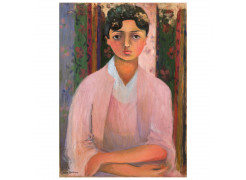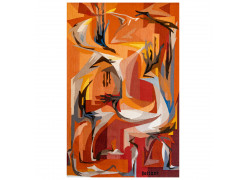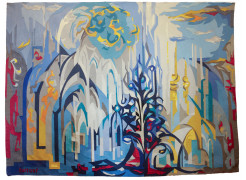Additional info:
Simone Baltaxé received her artistic education in Paris, first attending the School of Applied Arts before continuing at the École nationale supérieure des Beaux-Arts under the guidance of Jean Souverbie. The disruption caused by the Second World War led her to Lyon, yet her return to the French capital in 1946 reaffirmed her place within the post-war generation of artists who redefined the relationship between modernism and craftsmanship. Her relocation to Lebanon in 1951 marked a decisive transformation in her artistic development. The Mediterranean light and material richness of Beirut infused her practice with a renewed sensitivity that culminated in her engagement with tapestry, following her encounter with the master weaver George Audi in 1964. Baltaxé’s participation in the Salons du Printemps at UNESCO and in the Salons d’Automne at the Sursock Museum placed her at the heart of Lebanon’s vibrant artistic milieu during the 1950s and 1960s. Her solo exhibitions at Gallery One in 1968 and Modulart in 1974 confirmed the recognition of her singular approach to textile-based abstraction and chromatic construction. Her work, situated between painting and weaving, explores the tactile and spatial qualities of the surface through rhythm, density, and depth. Today, her works are housed in major public and private collections, including the Sursock Museum in Beirut, the Centre Pompidou, the Musée d’Art Moderne de Paris, Mathaf: Arab Museum of Modern Art in Doha, and the Saradar Collection. The recent institutional revival of interest in her oeuvre highlights the significant contribution of women artists whose practices extended the vocabulary of modernism beyond its European centre.
-
Octav Grigorescu
Bucharest, Romania, 1933 - Bucharest, Romania, 1987 -
IRWIN
b. 1983 -
Dia Al - Azzawi
b. Baghdad, Iraq, 1939 -
Ahmad Moualla
b. 1958 -
Henri Matisse
Le Cateau-Cambrésis, France, 1869 - Nice, France, 1954



